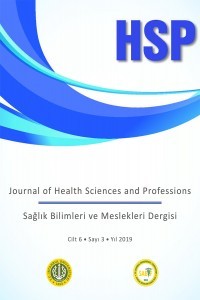Serebral Parezide Gözlemsel Yürüme Analizinin Yeri ve Kullanılabilirliği
Yürüme analizi, klinik değerlendirme, Serebral palsi, Güvenilirlik, Fizyoterapi
-
Physiotherapy, reliability, clinical practice, cerebral palsy, gait analysis,
___
- Silva M, Shepherd EF, Jackson WO, Dorey FJ, Schmalzried TP. [Average patient walking activity approaches 2 million cycles per year: pedometers under-record walking activity]. J. Arthroplasty. 2002; 17(6):693-7.
- Sequeira MM, Rickenbach M, Wietlisbach V, Tullen B, Schutz Y. [Physical activity assessment using a pedometer and its comparison with a questionnaire in a large population survey]. Am J Epidemiol. 1995;142(9):989-99.
- Perry, J. Fundimentals In: Gait Analysis: Normal and Pathological Function, 1.ed. New York; SLACK Incorporated, 1992, p. 1-19.
- Akalan N.E. 1999. Serebral parezili çocuklarda video bazlı gözlemsel yürüme analizinin gözlemci içi ve gözlemciler arası güvenilirliğinin belirlenmesi • Istanbul Universitesi, Sağlık Bilimleri Ens. Yüksek lisans Tezi. 79773.
- Maluin F: Observational Gait Analysis. In: Rebecca L. Craik, Carol A. Oatis, Gait Analysis, Theory and Application, 1.ed, Pennsylvania, Mosby, 1995. p.113-123.
- Reimers J. [A scoring system for the evaluation of ambulation in cerebral palsied patients]. Dev Med Child Neurol. 1972;14(3):332-5.
- Nelson AJ.[ Functional ambulation profile]. Phys Ther. 1974;54(10):1059-65.
- Olney SJ, Write MJ: Cerebral Palsy. In Campbell S K, Linden DWV, Palsido RJP: Physical Therapy For Children. Londra, 2. ed. W.B. Sounders Company, 1995: p.489-525.
- Wolfson L, Whipple, Amerman P.Tobin J.N. [Gait assessment in the Elderely: A gait abnormality rating scale and its relation to falls], Journal of Gerontology: Medical Sciences 1990; 45(1): 12-19.
- Krebs D. E. Edelstein J.E, Fishman S. [Reliability of observational gait analysis]. Physical Therapy, 1985; 65(7): 1027-33.
- Maathuis KG, van der Schans CP, van Iperen A, Rietman HS, Geertzen JH. [Gait in children with cerebral palsy: observer reliability of Physician Rating Scale and Edinburgh Visual Gait Analysis Interval Testing scale]. J Pediatr Orthop. 2005; 25(3):268-72.
- Caroll NC, Jones D, Maschuich W. [Evaluations patients to the gait children with miyelomeningocele]. Prostet. Orthot. Int.1982; 6:27-34.
- de Bruin H, Russell DJ, Latter JE, Sadler JT.[Angle-angle diagrams in monitoring and quantification of gait patterns for children with cerebral palsy]. Am J Phys Med. 1982;61(4):176-92.
- Goodkin R Diller L. [Reliability among physical therapistsin diagnosis and treatment of gait deviationin hemiplegics]. Perceptual and Motor Skills, 1991; 37:727-734.
- Robinson JL, Smidth GL. [Quantitative gait evaluation in clinic]. Physical Therapy 1981;61: 351-353.
- Patla AE, Clouse SD.[Visuel assessent of human gait: Reliability and validity]. Rehabil. Res. 1988; 1:87-96.
- Eastlack ME, Arvidson J, Snyder-Mackler L, Danoff JV, McGarvey CL.[ Interrater reliability of videotaped observational gait analysis]. Physical Therapy, 1991;71: 465-472.
- Winter DA. [ Concerning the scientific basis for the diagnosis of pathological gait and for rehabilitation protocols], Physiotherapy Canada, 1985; 37(4): 245-252.
- Miyazaki S. Kubotta T. [Quantification of gait abnormalities, on the basis of continuous foot- force measurement: correlation between quantitative indices and visual rating]. Med Biol. Eng. Comput 1984; 22:70-76.
- Saleh M, Murdoch G. [In defence of gait analysis: Observation and measurement in gait assessment]. The Journal of Bone and Joint Surgery.1985; 67(2):237-4.
- ISSN: 2148-7588
- Başlangıç: 2014
- Yayıncı: İstanbul Üniversitesi-Cerrahpaşa
Hüsniye DİNÇ, Saadet YAZICI, Tülay YILMAZ, Sevil GÜNAYDIN
Dört Avrupa Ülkesinde Ebeliğin Güncel Durumu ve Ebelik Araştırmalarının Gelişimi
Selma AYTAÇ, Meral MADENOĞLU KIVANÇ, Meral MADENOĞLU KIVANÇ, Fatma AY
Hemşirelerde Kas İskelet Ağrılarının Değerlendirilmesi
Asiye GÜL, Hülya ÜSTÜNDAĞ, Birşen KAHRAMAN, Sevim PURİSA
Serebral Parezide Gözlemsel Yürüme Analizinin Yeri ve Kullanılabilirliği
Perimenstrual Şikayetler ve Hemşirelik Yaklaşımı
Hemşirelerin Tıbbi Hata Eğilimlerine Yönelik Bir Çalışma
İşıl IŞIK ANDSOY, Gülcan KAR, Özlem ÖZTÜRK
Arzu RAZAK ÖZDİNÇLER, Arzu ÖZDİNÇLER, Ela TARAKCI, Ela TARAKCI, Seda BAKTIR, Seda BAKTIR, Esin ÖNDER
